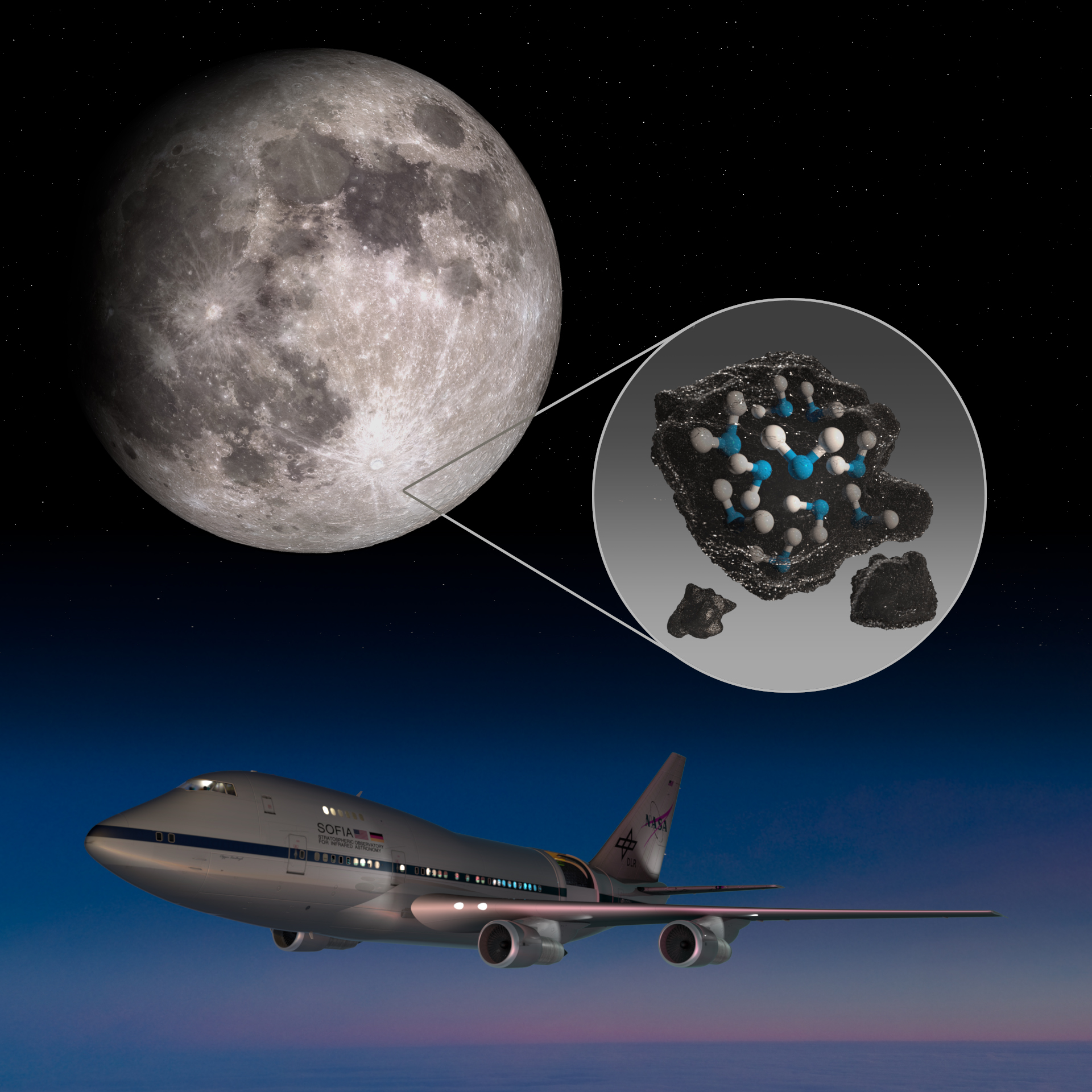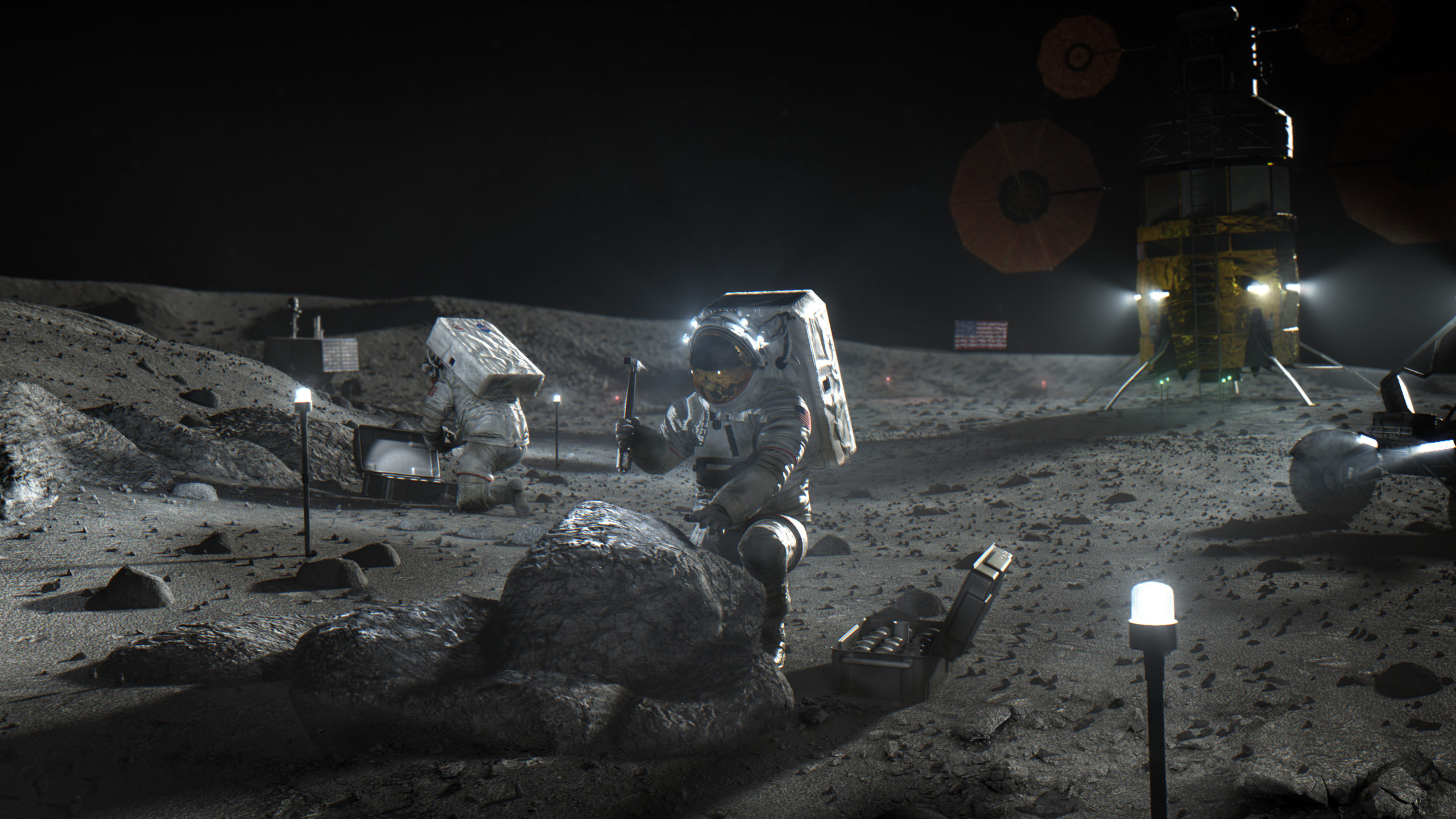
The Moon is generally thought of as a very dry place, with no surface water or even water vapor clouds. Nothing but arid, dusty regolith and rocks. That’s true for the most part, although there are deposits of water ice that have been found lurking in the permanent shadows of some craters near the lunar poles.
But now, NASA has confirmed something that previous studies had hinted at but not fully verified: water has been detected on the sunlit surface of the Moon. This means there may be a lot more water than previously thought, locked in the lunar soil, over much more of the Moon’s surface (although not global, according to the study).
The findings, from NASA’s Stratospheric Observatory for Infrared Astronomy (SOFIA), were announced by NASA and published in Nature Astronomy on October 26, 2020.
So what exactly has SOFIA discovered? The telescope detected, directly, water (H2O) molecules inside Clavius Crater in the Southern Hemisphere of the side of the Moon that faces Earth. This is significant for two reasons: this is the first confirmation of water in an area not always in colder, perpetual shadow, and is the first direct detection of the water molecules themselves.
Previous observations had hinted at this, but couldn’t quite make the distinction between actual water molecules and those of hydroxyl (OH), a close chemical relative.
“We had indications that H2O – the familiar water we know – might be present on the sunlit side of the Moon,” said Paul Hertz, director of the Astrophysics Division in the Science Mission Directorate at NASA Headquarters in Washington. “Now we know it is there. This discovery challenges our understanding of the lunar surface and raises intriguing questions about resources relevant for deep space exploration.”
The data suggests a concentration of water of 100 – 412 parts per million. That’s equivalent to a 12-oz bottle of water in a cubic meter of soil.
That’s not really a lot, and even the Sahara desert has 100 times that much water in its sands, but it is still significant given the harsh, airless conditions of the lunar surface.
The previous evidence for the hydrated soil had come from several missions as they flew past or orbited the Moon, including Cassini, Deep Impact and Chandrayaan-1, as well as the ground-based Infrared Telescope Facility. They all returned data suggesting that the soil in sunnier regions was hydrated, but none of them could definitively distinguish between H2O and OH.


“Prior to the SOFIA observations, we knew there was some kind of hydration,” said Casey Honniball, the lead author who published the results from her graduate thesis work at the University of Hawaii at Mānoa in Honolulu. “But we didn’t know how much, if any, was actually water molecules – like we drink every day – or something more like drain cleaner.”
The hydrated soil appears to be within a small range of latitude and not global. From the paper:
We find that the distribution of water over the small latitude range is a result of local geology and is probably not a global phenomenon. Lastly, we suggest that a majority of the water we detect must be stored within glasses or in voids between grains sheltered from the harsh lunar environment, allowing the water to remain on the lunar surface.
How did SOFIA make this distinction, when other observations could not? SOFIA looks at the Moon in infrared, not visible light. The 106-inch telescope flies on a modified Boeing 747SP jetliner, at altitudes up to 45,000 feet. That is a big advantage since it above 99% of the water vapor in Earth’s atmosphere, which allows it to get a clearer view in the infrared wavelength. Previous observations had often used the 3 microns water band in the infrared spectrum, but SOFIA was able to pick up the 6.1 microns wavelength, which is unique to water molecules, and not OH.


A concentration of the water molecules was found within Clavius Crater, where it is in full sunlight, unlike the craters near the lunar poles that are shrouded in perpetual darkness.
But just how the water remains in the soil is still a bit of a puzzle.
“Without a thick atmosphere, water on the sunlit lunar surface should just be lost to space,” said Honniball, who is now a postdoctoral fellow at NASA’s Goddard Space Flight Center in Greenbelt, Maryland. “Yet somehow we’re seeing it. Something is generating the water, and something must be trapping it there.”
Scientists have a few theories, including that micrometeorites bring small amounts of water to the surface, the Sun’s solar wind delivers hydrogen to the lunar surface, which causes a chemical reaction with oxygen-bearing minerals in the soil to create hydroxyl or that radiation from the impact of micrometeorites could transform hydroxyl into water.
It is also thought that the water could be stored in tiny bead-like structures in the soil, formed from the heat of micrometeorite impacts, or that it is trapped between grains of lunar soil.
The science aspect of this discovery is exciting, but there is some controversy as well. The NASA announcement also focused on how this water might be utilized by the planned upcoming crewed Artemis missions going back to the Moon later this decade. Those missions themselves have been the subject of much criticism and debate in the past few years. As astronomer Phil Plait stated on Twitter:
SOFIA will continue to search for more water in additional sunlit locations on the Moon. Even putting the Artemis debate aside for the moment, the data will add to the work of other future Moon missions, such as NASA’s Volatiles Investigating Polar Exploration Rover (VIPER), which will create the first water resource maps of the Moon for future human space exploration.
“It was, in fact, the first time SOFIA has looked at the Moon, and we weren’t even completely sure if we would get reliable data, but questions about the Moon’s water compelled us to try,” said Naseem Rangwala, SOFIA’s project scientist at NASA’s Ames Research Center in California’s Silicon Valley. “It’s incredible that this discovery came out of what was essentially a test, and now that we know we can do this, we’re planning more flights to do more observations.”
“Water is a valuable resource, for both scientific purposes and for use by our explorers,” said Jacob Bleacher, chief exploration scientist for NASA’s Human Exploration and Operations Mission Directorate. “If we can use the resources at the Moon, then we can carry less water and more equipment to help enable new scientific discoveries.”
There is also another new paper in the same issue of Nature Astronomy, using computer models and data from NASA’s Lunar Reconnaissance Orbiter, showing that water may also be trapped in small shadowed areas over more of the Moon’s surface than previously thought.
The new results show, again, that water – the elixir of life as we know it – is common throughout our Solar System, from the ocean moons in the outer Solar System to dwarf planets like Ceres, to Mars, Earth and even our own Moon.
More information about SOFIA is available on the mission website.
.
.
FOLLOW AmericaSpace on Facebook and Twitter!
.
.
Missions » SLS » Artemis »





Looking forward to an updated estimate of total water ice deposition at the lunar sphere—– 600 million tonnes {English Stan.} was previous estimate if I’m not mistaken